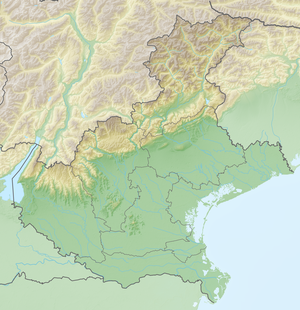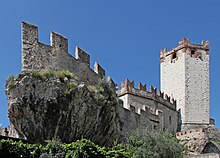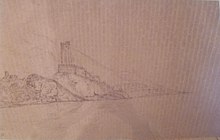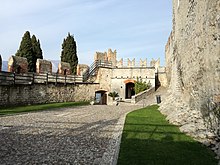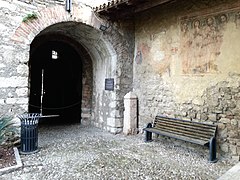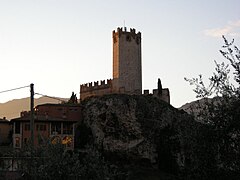Scaligerburg (Malcesine)
| Scaliger Castle Malcesine | ||
|---|---|---|
|
West side with Palazzo Veneziano, Palazzo Scaligero and keep |
||
| Creation time : | first mention 590 | |
| Castle type : | Hilltop castle | |
| Conservation status: | preserved, museum | |
| Place: | Malcesine | |
| Geographical location | 45 ° 45 '58.4 " N , 10 ° 48' 30.6" E | |
| Height: | 104 m slm | |
|
|
||
The Scaligerburg ( Italian Castello Scaligero ) in Malcesine is a hilltop castle in the Italian municipality of the same name on the east bank of Lake Garda in the province of Verona . The castle is known from the description of Goethe in his Italian trip .
location
The Scaligerburg is located at the northern end of the center of Malcesine on a natural hill that drops up to 30 m on three sides. The oldest part of Malcesine adjoins the castle walls on the gently sloping south side. On the east side, directly below the castle, is the Lacaòr open-air stage , which is covered with a tent roof .
history
Because of the elevated and protected location, one can assume that the castle hill served as a place of refuge as early as the Bronze and Iron Ages , especially since two creek cuttings to the south and east of it, no longer recognizable today, additionally protected the place. The first name of the castle hill could have been Lacaòr , as an area on the east side of the castle is still called today and where a small necropolis probably from the Etruscan period was discovered during excavations . The first settlement core of Malcesine formed around the Rocca, which during the Roman period slowly expanded southwards, as has been shown by finds.
The Lombards expanded the Rocca as a fortress in the 6th century, and shortly afterwards the complex was destroyed by the Franks in 590. When Malcesine fell under the rule of Charlemagne in 774 , it was rebuilt and expanded under Berengar I during the Hungarian invasions at the end of the 9th century.
In the following years the complex fell to the Bishop of Verona . In the first half of the 12th century, the now 15 m high was keep 1145 the castle increased and assumes its own territory and countryside. In 1157, Bishop Tebaldo II bequeathed it to his grandson Turrisando, under whose rule it was besieged in vain by Friedrich Barbarossa .
In 1277 Malcesine and the castle fell under the rule of the Scaliger . In the period that followed, they expanded the facility on the northern border of their domain. During this period, the most important expansion and renovation works of the castle took place, which were decisive for the fact that it was later generally referred to as the Scaligerburg. In the second half of the 14th century it became the seat of the Capitano, the deputy of the Gardesana dell'acqua , a customs union of several places on the eastern shore of the lake controlled by the Scaligers .
In 1387 the Scaligerburg was occupied by the troops of Gian Galeazzo Visconti . The rule of the Viscontis lasted until 1403. In 1405 Malcesine fell under the rule of the Republic of Venice . In 1506 it fell into the hands of the imperial troops but could already be recaptured in 1513 by the Venetian condottiere Scipione Ugoni . The Venetian era lasted until the 18th century. During this time, the castle underwent further major expansions and was temporarily the seat of the Venetian administration and the Venetian naval command on Lake Garda.
During the Napoleonic era, Malcesine and the castle were first occupied by the French in 1797 and by the Austrians in 1798. Between 1805 and 1814 it fell to the Kingdom of Italy and after the Congress of Vienna in 1815 it was incorporated into the Austrian Empire in the form of the Kingdom of Lombardy-Venetia . In this Austrian era, which lasted until 1866, the castle underwent its last major renovations. After the loss of Veneto in the Third Italian War of Independence and the annexation to the Kingdom of Italy , the Scaliger Castle was used as a border post for the Guardia di Finanza . In 1902 it was declared a national monument.
In the 1980s, the facility was extensively restored after individual piecework had been carried out after the Second World War . In 2013 the castle became the property of the municipality of Malcesine.
Goethe and the Scaligerburg
Goethe's description of the Italian journey in his travelogue made a significant contribution to the degree of popularity of the castle. Actually, Goethe had no intention of stopping in Malcesine when he set off from Torbole by boat in the early morning hours of September 13, 1786 . Already during the trip on the lake he noticed the Scaliger Castle and he made a sketch. When a headwind came up, it was no longer possible to continue the journey. Forced to go ashore in Malcesine, he wanted to make the best use of the forced stay and capture the picturesque castle in drawings. When he went to the apparently abandoned castle the next day to make drawings, a small crowd quickly gathered around him. He was asked what the drawings were about, and one of his drawings was even torn in two. He was suspected of being an Austrian spy and threatened to arrest him. Goethe's eloquence and his urbane demeanor quickly dissipated the suspicion. In the end he chatted with the local Gregorio, who was in service in Frankfurt am Main , about mutual acquaintances and was able to finally dispel any doubts about his actions and pull his way. That same night he set out to continue to Bardolino . Goethe recorded this adventure in detail in his diary and made the Scaligerburg and Malcesine famous.
description
The castle of Malcesine is a conglomerate of different buildings from different building eras, which has developed over centuries, even if the commonly used name Scaligerburg only refers to a very specific epoch. Even if it cannot be determined when and who was the first to build or settle the castle hill, one can distinguish between four different construction periods based on the buildings that have been preserved. During these construction phases, the castle gradually expanded from the highest point downwards.
Entrance area
The Scaligerburg has two entrances. The entrance used today as an access, called Posterla, faces the lake and was built during the Venetian era. It shows how the strategic importance of the complex has changed over the centuries from the land to the sea side, as the original entrance was below the keep on the inland side. Before the castle gate, a path leads down to a small bay that the Venetians used as a landing stage. In the 19th century the Austrians protected the entrance with a small moat and a bridge as well as a second wall with loopholes .
Lower courtyard
The lower inner courtyard is about 24 m above the lake surface and was also created with the new entrance area during the Venetian era. The striking Palazzo Veneziano to the left of the entrance was the seat of the Venetian deputy, the Capitanos, until 1618, who was in charge of the trade in goods on the lake. After the relocation of the offices to the Palazzo dei Capitani , the building was used as a barracks, which is why it is also known as Casermetta . The striking outside staircase dates from 1622, as can be seen from the plaque above the staircase. The three-story building houses a branch of the Natural History Museum of Verona . In nine exhibition rooms spread over two floors, which were completely redesigned in 2008, one deals with various aspects of the natural history of Lake Garda and Monte Baldo . The outer wall that surrounds the lower inner courtyard, like the ramp leading up to the Zwinger , was laid out by the Austrians in the 19th century.
Kennel
The Zwinger, which is about 9 m higher, now has two passages from the entrance area below. The Zwingermauer from the Scaliger period forms the actual outer wall of the castle. The powder chamber in the northwest corner of the Zwinger is the castle's youngest building and was built by the Austrians in the 19th century. It later served as a prison for the Guardia di Finanza. The powder chamber, which was restored in the 1980s, now houses two exhibition halls. The larger of the two rooms shows the Austrian project sketches from the last phase of renovation in the 19th century, while the second room deals with Goethe's stay in Malcesine.
On the roof of the powder chamber, guns could be positioned that took fire on the north side. From here a battlement leads along the Zwinger wall built by the Scaligers to the southern area of the Zwinger. There is a ramp built by the Venetians in the 15th century, which was used to pull cannons onto the southern Ravelin . The Venetian artillery was aimed at the defense of the sea side, as inferior to the curved battlements on this side.
The old former entrance to the Scaligerburg is located on the south-eastern side of the Zwinger below the keep. Next to the entrance there are remains of frescoes from the 14th century and a grave slab, which indicate a former castle chapel . The outer wall of Palazzo Scaligero with its characteristic dovetail crenellations borders the east side of the Zwinger .
Inner castle area
The access to the inner castle area is next to the powder room on the north side of the castle. This is 6 m higher than the kennel and is protected by a circular wall and battlements. The inner courtyard is almost completely filled by the foot of the keep, which is one of the oldest parts of the castle. Originally the tower was only 15 m high and ended on the second floor. The former entrance was also located here, which could be reached via a staircase that is no longer available today. The barred former entrance door facing the lake has been preserved. The vault below was probably used as a dungeon and was only accessible through a narrow hole in the floor. The walls of the tower, made of ashlar and with humpback blocks on the edges , are 2.5 m thick and have only a few narrow arches . When the tower was built cannot be determined. In any case, in 1131 it was raised by two floors, as emerged from an inscription in the vault of the fourth floor that is no longer legible. The Scaliger added another floor to the tower, the brickwork of which is only 80 cm thick. This fourth floor has six openings and served as a lookout. A fire and water point made permanent occupation possible for longer periods of time. The platform above, on which the community bell, cast in the 15th century stands, was not built until 1909, when the original wooden roof was replaced by a concrete structure. Today the entrance to the 31 m high keep is on the first floor. The access from the courtyard below was laid out by the Austrians in the 19th century. Next to the tower, in the southwest corner of the inner courtyard with the two-story Palazzo Scaligero, is the Palas . As with the donjon, its origin cannot be determined. On the outer wall facing the Zwinger, different architectural styles and materials can be seen, which allow the conclusion that the palace built by the Scaligers is based on a previous building of unknown origin. In the palazzo, which was built between the 13th and 14th centuries, there are two exhibition halls in the basement. In the first larger room one deals with the Venetian shipping history on Lake Garda. The transport of the Venetian fleet from the Adige Valley by land to Torbole in the company known as Galeas per montes is also discussed . The history of the castle and Malcesines is illustrated in the adjoining room. The upper hall of the Palas, on the other hand, serves as an event hall. In the inner courtyard there is also the castle fountain and two latrines built by the Austrians , which are embedded in the northern wall. In the north-eastern corner there is a Byzantine-style Madonna fresco , which was only discovered in 1949.
photos
literature
- Casa di Goethe , Comune di Malcesine (ed.): Goethe in Malcesine. Castello Scaligero , Comune di Malcesine, Malcesine 2004.
- Eugenio Cipriani: Il Castello Scaligero di Malcesine ei suoi musei , Cierre Edizioni, Verona n.d.
- Comitato del Museo Castello Scaligero di Malcesine (ed.): Malcesine e Goethe , Verona 1983.
- Ierma Sega, Christian Terzer: Malcesine. Il Castello e il Monte Baldo , ViaDellaTerra, Rovereto 2008 ISBN 978-88-7558-045-2 .
Web links
Individual evidence
- ^ Eugenio Cipriani: Il Castello Scaligero di Malcesine ei suoi musei p. 7
- ↑ a b Eugenio Cipriani: Il Castello Scaligero di Malcesine ei suoi musei p. 9
- ↑ Comitato del Museo Castello Scaligero di Malcesine (ed.): Malcesine e Goethe p. 73
- ↑ Comitato del Museo Castello Scaligero di Malcesine (ed.): Malcesine e Goethe p. 74
- ↑ Comitato del Museo Castello Scaligero di Malcesine (ed.): Malcesine e Goethe p. 75
- ↑ a b Comitato del Museo Castello Scaligero di Malcesine (ed.): Malcesine e Goethe p. 76
- ↑ a b Eugenio Cipriani: Il Castello Scaligero di Malcesine ei suoi musei p. 13
- ^ History of the castle (Italian) accessed on January 29, 2018
- ↑ Casa di Goethe, Comune di Malcesine (ed.): Goethe in Malcesine. Castello Scaligero p. 19
- ↑ Ierma Sega, Christian Terzer: Malcesine. Il Castello e il Monte Baldo pp. 26-27
- ↑ Comitato del Museo Castello Scaligero di Malcesine (ed.): Malcesine e Goethe pp. 78–83
- ↑ Ierma Sega, Christian Terzer: Malcesine. Il Castello e il Monte Baldo pp. 32–35
- ↑ Ierma Sega, Christian Terzer: Malcesine. Il Castello e il Monte Baldo pp. 41–42

